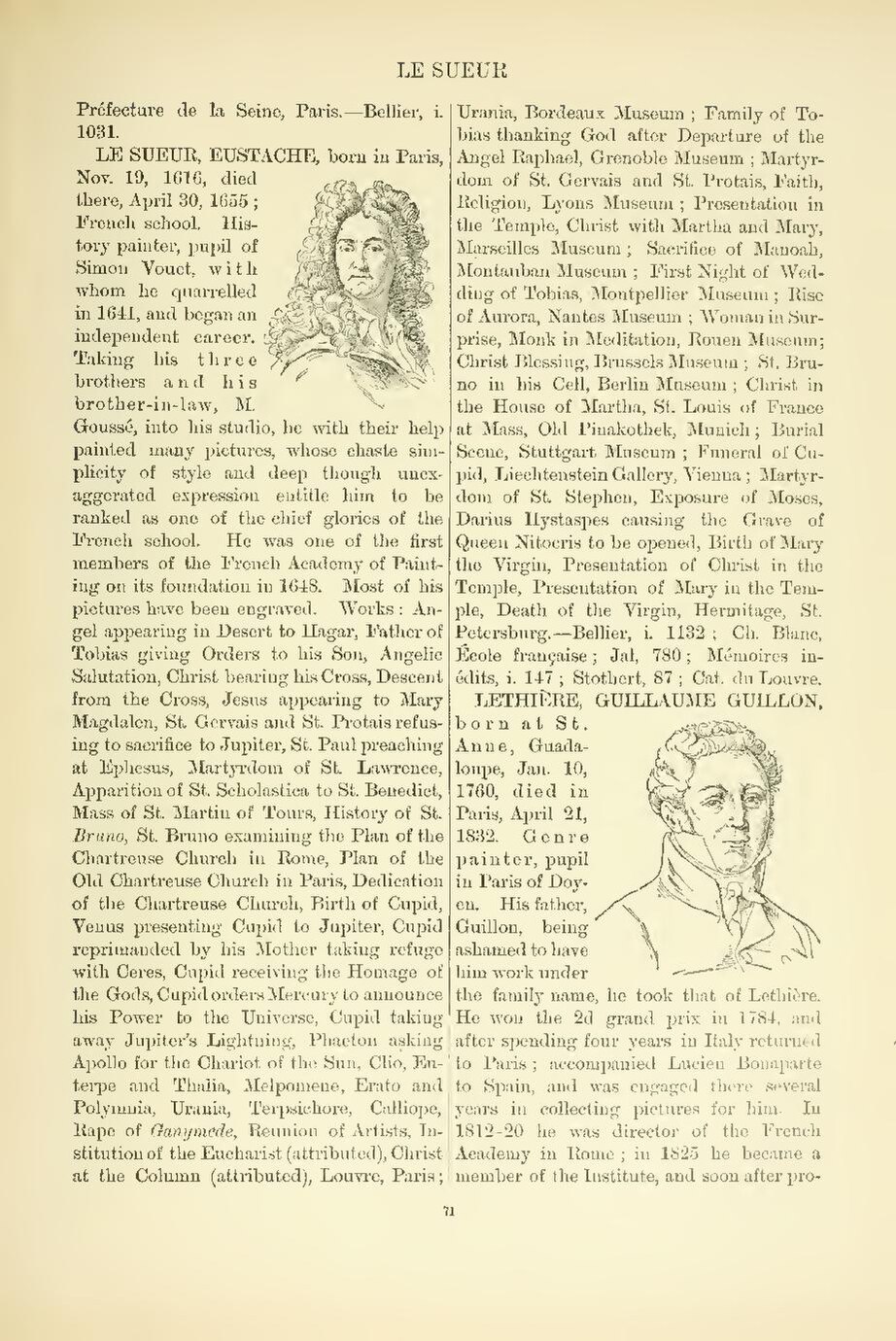Préfecture de la Seine, Paris.—Bellier, i. 1031.
An image should appear at this position in the text. To use the entire page scan as a placeholder, edit this page and replace "{{missing image}}" with "{{raw image|Cyclopedia of painters and paintings (IA cyclopediaofpain03cham).pdf/93}}". Otherwise, if you are able to provide the image then please do so. For guidance, see Wikisource:Image guidelines and Help:Adding images. |
LE SUEUR, EUSTACHE, born in Paris,
Nov. 19, 1616, died
there, April 30, 1655;
French school. History
painter, pupil of
Simon Vouet, with
whom he quarrelled
in 1641, and began an
independent career.
Taking his three
brothers and his
brother-in-law, M.
Goussé, into his studio, he with their help
painted many pictures, whose chaste simplicity
of style and deep though unexaggerated
expression entitle him to be
ranked as one of the chief glories of the
French school. He was one of the first
members of the French Academy of Painting
on its foundation in 1648. Most of his
pictures have been engraved. Works: Angel
appearing in Desert to Hagar, Father of
Tobias giving Orders to his Son, Angelic
Salutation, Christ bearing his Cross, Descent
from the Cross, Jesus appearing to Mary
Magdalen, St. Gervais and St. Protais refusing
to sacrifice to Jupiter, St. Paul preaching
at Ephesus, Martyrdom of St. Lawrence,
Apparition of St. Scholastica to St. Benedict,
Mass of St. Martin of Tours, History of St.
Bruno, St. Bruno examining the Plan of the
Chartreuse Church in Rome, Plan of the
Old Chartreuse Church in Paris, Dedication
of the Chartreuse Church, Birth of Cupid,
Venus presenting Cupid to Jupiter, Cupid
reprimanded by his Mother taking refuge
with Ceres, Cupid receiving the Homage of
the Gods, Cupid orders Mercury to announce
his Power to the Universe, Cupid taking
away Jupiter's Lightning, Phaeton asking
Apollo for the Chariot of the Sun, Clio, Euterpe
and Thalia, Melpomene, Erato and
Polymnia, Urania, Terpsichore, Calliope,
Rape of Ganymede, Reunion of Artists, Institution
of the Eucharist (attributed), Christ
at the Column (attributed), Louvre, Paris;
Urania, Bordeaux Museum; Family of Tobias
thanking God after Departure of the
Angel Raphael, Grenoble Museum; Martyrdom
of St. Gervais and St. Protais, Faith,
Religion, Lyons Museum; Presentation in
the Temple, Christ with Martha and Mary,
Marseilles Museum; Sacrifice of Manoah,
Montauban Museum; First Night of Wedding
of Tobias, Montpellier Museum; Rise
of Aurora, Nantes Museum; Woman in Surprise,
Monk in Meditation, Rouen Museum;
Christ Blessing, Brussels Museum; St. Bruno
in his Cell, Berlin Museum; Christ in
the House of Martha, St. Louis of France
at Mass, Old Pinakothek, Munich; Burial
Scene, Stuttgart Museum; Funeral of Cupid,
Liechtenstein Gallery, Vienna; Martyrdom
of St. Stephen, Exposure of Moses,
Darius Hystaspes causing the Grave of
Queen Nitocris to be opened, Birth of Mary
the Virgin, Presentation of Christ in the
Temple, Presentation of Mary in the Temple,
Death of the Virgin, Hermitage, St.
Petersburg.—Bellier, i. 1132; Ch. Blanc,
École française; Jal, 780; Mémoires inédits,
i. 147; Stothert, 87; Cat. du Louvre.
An image should appear at this position in the text. To use the entire page scan as a placeholder, edit this page and replace "{{missing image}}" with "{{raw image|Cyclopedia of painters and paintings (IA cyclopediaofpain03cham).pdf/93}}". Otherwise, if you are able to provide the image then please do so. For guidance, see Wikisource:Image guidelines and Help:Adding images. |
LETHIÈRE, GUILLAUME GUILLON,
born at St.
Anne, Guadaloupe,
Jan. 10,
1760, died in
Paris, April 21,
1832. Genre
painter, pupil
in Paris of Doyen.
His father,
Guillon, being
ashamed to have
him work under
the family name, he took that of Lethière.
He won the 2d grand prix in 1784, and
after spending four years in Italy returned
to Paris; accompanied Lucien Bonaparte
to Spain, and was engaged there several
years in collecting pictures for him. In
1812-20 he was director of the French
Academy in Rome; in 1825 he became a
member of the Institute, and soon after pro-
